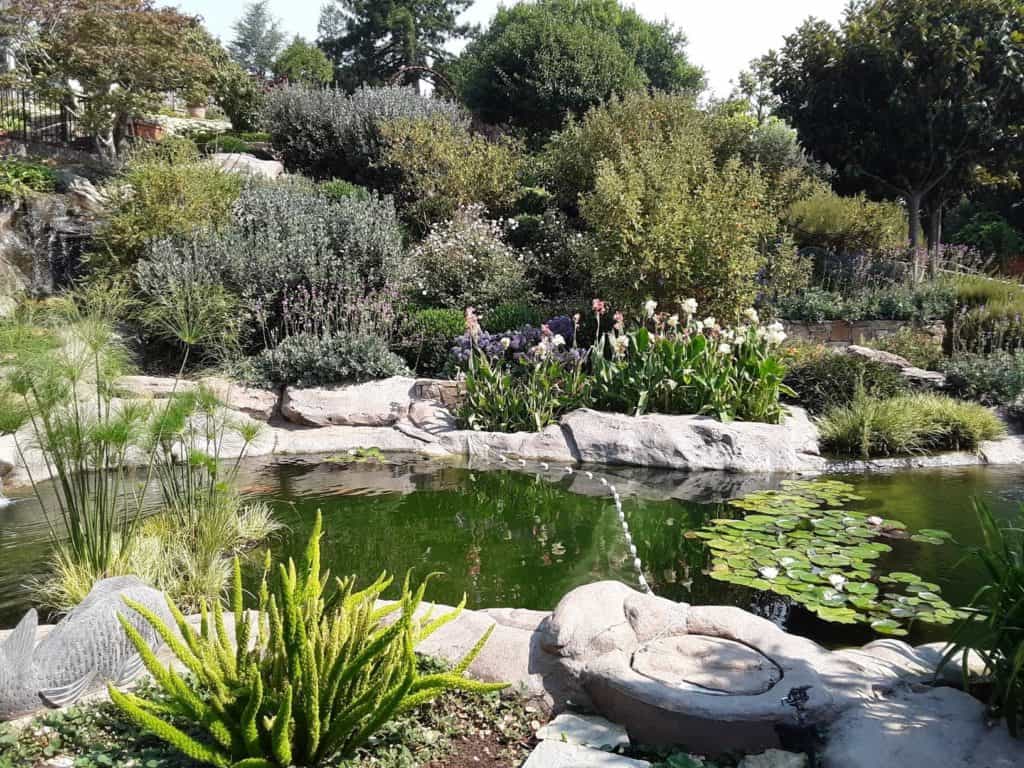**Post contains affiliate links where we make $$ for our product recommendations.**
What are the basic requirements for a koi fish pond? What can be kept in a pond besides koi? How do you breed koi fish? What do koi fish in a pond eat? We’ll answer all your burning koi fish pond basic questions and more! For a more comprehensive overview, we recommend you take a look at our Koi Health Seminar Series. This program includes five modules with 30-minute lectures, accompanying slides, downloadable handouts and comprehension quizzes.

How to Build a Koi Fish Pond
There are many “right” ways to build a koi pond. Keep in mind that any pond built for fish is more complicated than digging a hole and throwing fish in. A koi pond requires careful planning to be sure everything works as it should. If you are new to the koi hobby, we strongly recommend consulting with a professional before you begin. Here are some great videos covering all the basics of koi pond design and building.
How to Care for Koi Fish
Fish are NOT “maintenance-free” pets! You will need to continually care for them throughout their life times. For koi, this could be 40-60 years! Too long for you? Then don’t buy a koi.
Maintenance Routine
Maintaining your koi pond is a regular chore. You do NOT have to remove the koi fish to clean your pond! Here is how to clean a koi pond with the fish in it:
Before you start: How much water do you plan to drain from your koi fish pond? We recommend no more than 50% at one time. Is there a particular level that will cause your filtration to malfunction? Do you have no idea what I am talking about? Probably best you consult a professional maintenance service.
If you have a bottom drain, your maintenance is best done using a soft broom to push everything towards the filtration. No bottom drain? You will need to use a pond vacuum. We recommend this one, with two chambers to make things easy.
To easily clean your pond, it is best to have a bare bottom with no substrate. Yes, we know it’s not as pretty, but it’s a LOT easier to vacuum!
If you have a pressurized bead filter, it is best that you backwash it weekly. This will keep your biomedia from becoming compacted and ineffective.
If you have matting, strapping or other filter materials, NEVER pressure wash it or use chlorinated water! Simply shake it our or rinse it in waste water and replace. It will smell and “look dirty,” but that is OKAY!
Here is a complete list of pond maintenance tasks on a daily, weekly, monthly and yearly cycle.
What to Feed Koi Fish in a Pond
Koi metabolism, being ectotherms like other fish, will follow the changes in water temperatures. Colder water = slower metabolism = koi not so hungry. Warmer water = faster metabolism = hungry koi! There are MANY koi diets available to koi owners, and not all are created equal. Here is how to break down labeling on koi food and pick the best food for your fish. Our you can just buy this one, our favorite recommendation.
Checking your Koi Fish Pond for Disease
Disease in fish falls into two categories: physical and behavioral. Physical changes involve the actual appearance of your fish, including spots, lumps and fin issues. Behavioral issues involve how your fish is behaving, namely their swimming, appetite and interaction with other fish. Here is our webinar all about recognizing various signs of disease in fish.
Koi fish are susceptible to many diseases. There are various diseases caused by bacteria, parasites, fungi and viruses. To best serve your fish, we recommend yearly veterinary assessments to make sure your fish stay healthy and well.
How to Breed Koi Fish in a Pond
A majority of koi fish ponds are already overstocked. We recommend a conservative 250 gallons/koi in order for your fish to have optimal health. If you have the space and would like to breed your koi, or want to sell the offspring, there are many specific cues your fish require.
Most koi fish ponds will spawn in the late spring or early summer. This is directed by the light/dark daylight patterns and water temperature. Koi like to have plants or spawning brushes in their pond to lay their eggs on. These can be removed to the breeding pond after spawning. Spawning can be a very aggressive ordeal, with males chasing females, in some case, into rocks, the sides of their pond and even causing them to jump out.
If you have an accidental spawning, it is unlikely that may babies will survive. The adults will eat most of the eggs, and this is NORMAL! Many of them will end up in your filtration, so expect a small ammonia spike post-spawning.
For more information on koi reproduction, we recommend you check out our Koi Health Seminar – Reproduction Module.
More Information on Koi Fish
If you are interested in learning more about koi fish, we recommend joining your local koi fish club. Many of these clubs also offer pond tours and put on koi shows for the public. This is a great chance to learn if keeping koi is for you.
